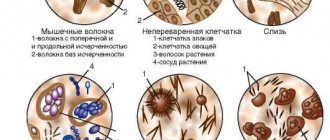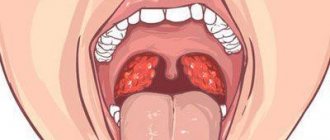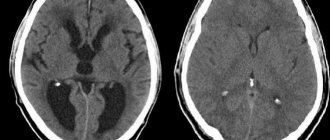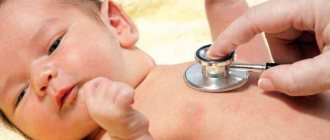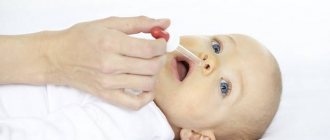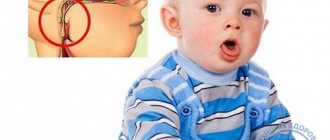Definition and classification
Nervous tics are muscle contractions of a pathological nature that occur occasionally or regularly. In children, as a rule, it has a paroxysmal type. An exacerbation of the condition is most often observed in the presence of an unpleasant or dangerous situation.
There are local as well as generalized nervous tics. The first are contractions of single muscle groups, the second - several.
There are:
- vocal;
- facial tics;
- motor.
According to duration they are distinguished:
- transistor - last less than a year, can disappear on their own and then appear again;
- chronic - characterized by long-term presence, more than a year.
Types and causes of tremor
Two categories of the condition are defined: physiological and pathological tics. The first type is short-lived and short in amplitude, occurring during crying or feeding. The muscles of the chin, lips, and less often the limbs are involved in the process. Distinctive features of physiological tremor:
- the duration of the attack, the tone is normalized within 5 seconds;
- appears immediately after provoking factors, the cause is eliminated, trembling stops;
- the debut occurs in the first days of life; over time, episodes become rare and disappear completely.
Signs of tics are clearly pronounced in premature babies, in which case the symptoms are much more common.
As the nervous system develops, the manifestations disappear. Physiological tremor is a normal condition and should not cause concern to parents.
The pathological variety differs in that the tic affects not only the muscles of the face and limbs, but also the head. May be an indicator of a neurological disease. In this case, convulsions can spread to the entire body of the child, accompanied by crying and anxiety.
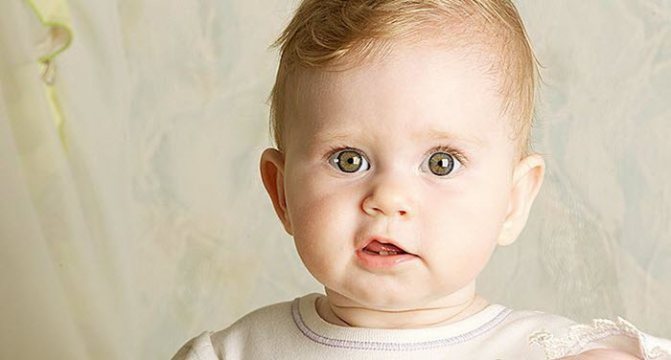
In newborns
The cause of short-term muscle contraction in infants is an immature nervous system and a poorly formed endocrine system. A physiological tic can cause:
- hypothermia;
- pain;
- bloating;
- hunger;
- sharp sound or light.
In this case, chin tremor in a baby may be the only manifestation of overexcitation of the nervous system.
If the condition is long-term, accompanied by blueness of the skin, trembling of the head, a tic occurs without an obvious irritant, we are talking about pathology.
Nerve twitching can occur due to a number of factors that cause brain damage:
- placental abruption;
- infection of the fetus during the perinatal period;
- hypoxia due to the umbilical cord wrapped around the neck;
- weak or premature labor;
- use of drugs and alcohol by women.
The pathological phenomenon is based on frequent stress during pregnancy.
In children after 1 year
Nervous tics in children of preschool age and older manifest themselves in 25% of cases in boys and 15% in girls. In most cases, the condition is not a disease and goes away on its own. If nervous twitching is clearly expressed, causes discomfort to the child, and entails psycho-emotional discomfort, we are talking about a pathological symptom of a nervous system disorder. After a year of life, hyperkinesis of this type is divided into motor and vocal. The first type includes:
- frequent eye blinking in children;
- change in facial expressions (grimace);
- wrinkles on the forehead and bridge of the nose;
- twitching of a leg or arm, head;
- Grinding of teeth (caused by worms).
A vocal tic is:
- periodic snorting;
- noisy exhalation of air through the nose;
- involuntary hissing;
- intermittent cough.
Depending on the state of the nervous system, tremor is divided into primary and secondary.
Idiopathic manifests itself between the ages of 10 and 13 years, during the period of psychomotor formation. The reasons that caused the disorder include:
- stress overstrain: insufficient attention from parents, difficult living conditions, unhealthy microclimate in the family or children's group;
- mental trauma: quarrel with peers, fear, violence;
- emotional shock associated with a change in the usual way of life: the first day of school, an unfamiliar team, new rules;
- poor diet, lacking calcium and magnesium;
- mental fatigue;
- heredity.
Based on the nature of the distribution of muscle contractions, the primary type is defined as local, multiple, generalized. The duration of manifestation is transient - from 14 days to 12 months, chronic - from a year or more.
Secondary tremor occurs against the background of anomalies:
- genetic disorder in the nervous system;
- hereditary abnormalities - dystonia or chorea;
- infectious diseases and viruses: encephalitis, streptococcus, herpes;
- head trauma, intracranial tumors;
- neuralgia of the facial nerve;
- taking antipsychotic medications, antidepressants.
Nature of occurrence
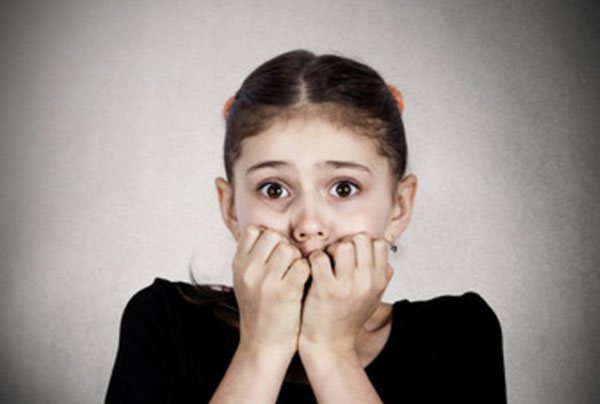
The reasons why a nervous tic can develop are most often the following:
- hereditary predisposition;
- lack of attention from parents or their overprotection;
- early infectious disease, especially influenza, intoxication of the body;
- dysmetabolic or organic lesions in the brain, excess production of dopamine;
- turbulent environment - situations when the baby cannot feel protected in a team or in the family, experiences excessive nervousness, which subsequently results in the appearance of tics;
- excessive mental stress, excessive demands placed on the child regarding studies or sports achievements;
- improper diet - a situation when there is a lack of vitamins and microelements in the baby’s body, in particular magnesium or calcium;
- excessive consumption of drinks that have a stimulating effect on the nervous system (coffee, strong black tea);
- severe stress - this can be constant domestic scandals, parental divorce, the presence of an alcoholic in the family, the death of a relative or friend, sexual or physical violence.
Causes
There are many reasons for the appearance of nervous tics in children, but the main ones are:
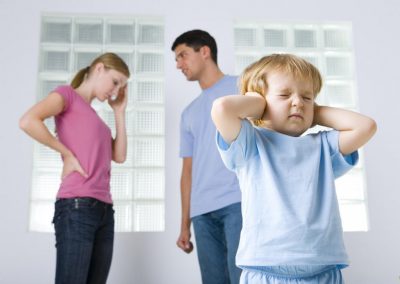
Frequent stressful situations in the family that can arise due to parental scandals.- Many children develop a nervous tic when entering first grade. This is due to an unusual environment for the child, emotional stress, and workload. In most cases, such tics go away on their own after some time, as soon as the child gets into a rut.
- Poor nutrition, in which most children do not receive the required amount of nutrients and microelements, can also cause the formation of nervous tics and other mental disorders.
- Often the cause of tics can be a genetic predisposition. So, if tics can be observed in one of the parents, then the possibility of developing tics in children cannot be ruled out.
Characteristic manifestations
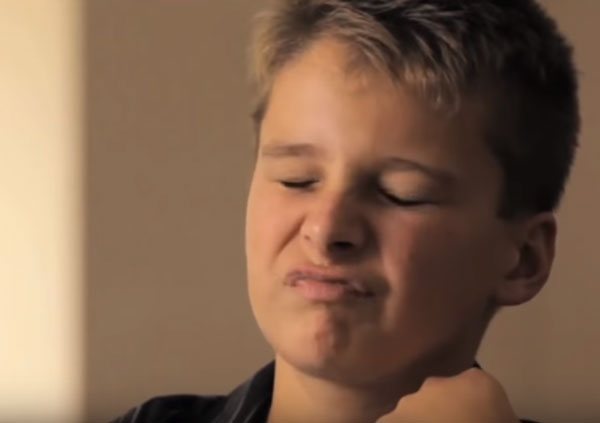
Mimic tic
There are certain symptoms that may indicate the presence of a tic. The main distinguishing feature is the absence of manifestations at night.
Signs of facial tics include:
- change in the lumen of the nostrils;
- wrinkling of the nose, which is unnatural;
- tension of the nasal wings;
- closing and opening the mouth;
- twitching of lips, cheeks;
- “twitching eye”, constant blinking, squinting;
- chin trembling;
- moving eyebrows;
- circular eye movements.
Vocals include:
- frequent smacking, sniffling, muttering;
- pronunciation of certain sounds;
- uncontrollable need for obscene, cynical language, pronunciation of curses;
- constant repetition of words heard earlier from other people;
- the child’s need to repeat phrases or individual words over and over again, with an increase in the speed of pronunciation and a change in voice intonation;
- There may be unintelligibility of what is spoken.
The presence of motor tics is indicated by the following signs:
- obscene gestures;
- sudden shuddering;
- recalculation of certain objects;
- indecent acts;
- constant touching of certain parts of the body;
- inattention;
- fussiness;
- excessive impatience;
- special attention to personal hygiene;
- arranging objects in a certain sequence;
- inability to finish what is started;
- lack of perseverance;
- excessive noise.
Diagnostics
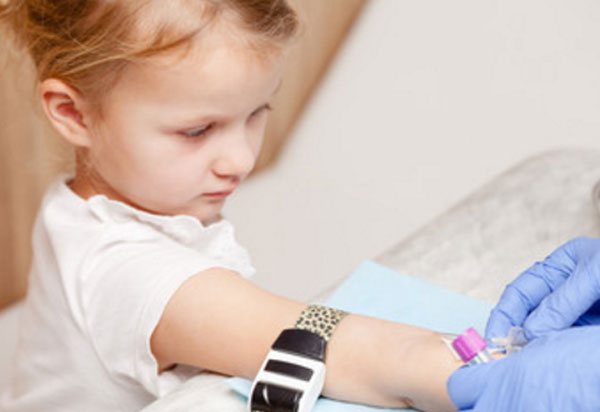
Before thinking about how to treat a child who often has tics, it is necessary to determine the correct diagnosis.
- First of all, you need to seek advice from a pediatrician, who can refer you to a neurologist. Most often, a visit to a specialist is required if the following points exist:
- increased intensity;
- the negative impact of this condition on problems with adaptation in a new team;
- negative impact on the baby’s quality of life;
- tic persistence for more than four weeks;
- the appearance of several ticks at the same time.
- The neurologist will examine the child, check for reflexes, and find out what the complaints are. After which he will be able to refer you for additional examination:
- general blood test - to rule out infection;
- stool analysis for helminthic infestations, since parasites can affect the occurrence of involuntary movements;
- ionogram - to identify the level of microelements;
- MRI of the head, electroencephalography - to exclude complications after injury, identify neoplasms, serious pathologies of the nervous system.
- If a specialist suspects problems of a psychological nature, the child will be referred to a psychologist or psychotherapist.
Nervous tic in a child: is therapy needed?
A nervous tic is a subtype of dyskinesia, in which the muscle structures of some parts of the body involuntarily contract due to errors in impulses sent by the brain.
In most cases, nervous tics in a child are not a sign of serious abnormalities in the functioning of the brain and occur under the influence of strong emotional overload, prolonged stress, and lack of sleep.
They often occur in children suffering from various types of neuroses and phobias. If a child regularly experiences involuntary muscle movements, he should be taken to a pediatric neurologist and psychotherapist .
How to treat distracted attention in a child? Find out about this from our article.
Nervous tics have a huge number of subtypes , so some of their manifestations confuse adults.
Parents, educators or teachers may decide that the child is deliberately grimacing, playing around, and punish him.
This occurs due to lack of awareness and works to the detriment of the child: he will become more nervous, and his nervous tics will worsen, and new ones may appear.
Children growing up in unfavorable environments are more likely to experience tics, and inadequate treatment of them by other people contributes to the development of complexes that can seriously complicate life.
Facts about nervous tics:
- The child rarely notices manifestations of tics and does not feel uncomfortable.
- Involuntary motor activity can be suppressed by willpower for some time, but gradually the child will begin to feel discomfort, tension, and movements will resume.
- Several nervous tics can be observed at the same time.
- Involuntary motor activity is observed only when the child is not sleeping.
Reasons for appearance
The main causes of idiopathic (not related to brain disorders) tics:
- Severe stress : divorce of parents, scandals in the family, drunkenness of close relatives, death of a friend or relative, an episode of mental, physical or sexual violence - all this can affect the occurrence of spontaneous motor activity.
- First grader tick. A significant number of children experience involuntary movements in the first weeks after starting school. The period of adaptation to school is extremely difficult, so deviations in the functioning of the nervous system are observed even in children who have never previously had nervous tics or other psychoneurological disorders.
- Wrong diet. If a child does not receive enough nutrients from food, especially magnesium and calcium, the likelihood of tics and other similar disorders increases.
- Excessive consumption of drinks that have a stimulating effect on the nervous system (coffee, energy drinks, strong black tea). Applies mainly to older children.
- Overwork. Excessive physical and mental stress adversely affects the functioning of the nervous system, which leads to the occurrence of tics.
- Presence of genetic predisposition. If one or both parents have periodic tics, the child may also experience them.
Also, nervous tics may appear against the background of the following disorders :
- deviations in the process of intrauterine brain formation;
- traumatic injuries of the skull (brain contusion, concussion, intracranial hemorrhage);
- infectious brain damage (meningitis, encephalitis);
- taking certain medications (antipsychotics, tranquilizers, antidepressants, anticonvulsants);
- intoxication of various etiologies (heavy metals, ethanol, narcotic substances, toxic substances of plant origin, carbon monoxide);
- benign and malignant neoplasms in brain tissue;
- trigeminal neuralgia;
- genetic pathologies (Huntington's chorea, Tourette's syndrome).
25% of children from six to ten years old have had nervous tics at least once.
In girls, this deviation is observed three times less often than in boys.
Nervous tics can be observed in children at any age , but their peak occurs during difficult periods, which include adaptation to a new team, a new environment, and age-related crises.
In infants, tics are observed quite rarely and more often indicate the presence of disturbances in the functioning of the brain.
Kinds
Nervous tics are divided into:
- Motor: movements of the limbs (swinging, twitching, knocking, stomping), obsessive swallowing of saliva, grimaces, frequent blinking of the eyes, winking, twitching of the head, cheek, biting the lips and the inside of the cheeks.
- Vocal: hissing, whistling, pronouncing individual sounds (“u-u-u-u”, “ay”, “i-i-i”), clearing the throat, sniffling, uttering swear words, repeating an already spoken word in a whisper or out loud, repeating phrases after someone.
Depending on the causes of occurrence, there are:
- primary nervous tics. They are also called idiopathic. They are an independent deviation;
- secondary. Associated with the presence of disturbances in the functioning of the nervous system.
Based on duration, nervous tics are divided into:
- Transistor. A nervous tic lasts less than a year, may disappear on its own and reappear over time. In most cases, they rarely last more than one month.
- Chronic. Involuntary motor activity is observed for a long time (more than a year).
Also, tics can be simple or complex.
Read about the symptoms and treatment of cerebrasthenic syndrome in children here.
Symptoms and signs
Tics can be very diverse, but they have a number of features by which they can be recognized:
- Constant repetition of the same tic. A person observing a child from the side can notice repeated actions: the child shakes his head, or twirls a pen in his hands, or makes a specific sound, or twitches his cheek, and this involuntary action is reproduced many times over a long time.
- Tics worsen when the child is worried, tense, scared , and some tics that were observed before may also return.
- If you ask a child to control a tic, he will not be able to do so, and the symptoms of the tic may even worsen. Some ignorant adults have a very negative attitude towards this feature.
The most important thing is not to scold your child: he really cannot stop it easily.
Mechanism of occurrence of the disorder
The extrapyramidal system of the brain, in the presence of provoking factors (psycho-emotional overload, diseases of the nervous system, overwork, etc.), begins to work too actively: it sends an excessive number of impulses.
These impulses travel along nerve structures and contact synapses, resulting in involuntary movements.
If a nervous tic is repeated very often , the child gets tired, and he may experience pain in the muscles that are involved in involuntary motor activity.
If you do not pay the child's attention to a nervous tic, involuntary movements will disappear faster.
Features of the course depend on the psycho-emotional state, the presence or absence of diseases of the nervous system, and the number of provoking factors.
Diagnostics
If a child has nervous tics, he should be taken to a pediatrician, who will give a referral to a neurologist.
Indications for visiting a neurologist:
- high tic intensity;
- involuntary movements significantly worsen the child’s quality of life;
- physical activity complicates the process of adaptation to a new team;
- a nervous tic does not go away for more than three to four weeks;
- Several tics are observed simultaneously.
A neurologist examines the child, checks his reflexes, asks questions and refers him to additional diagnostic measures:
- Clinical blood test. Allows you to exclude infectious diseases.
- Fecal analysis. Worms may be a factor influencing the occurrence of involuntary movements.
- Ionogram. Allows you to identify shortages of useful elements.
- MRI of the brain and electroencephalography. They allow us to exclude neoplasms, complications after injuries, and serious pathologies of the nervous system.
If a psychogenic nature of the deviation is suspected, consultation with a psychotherapist and psychiatrist is indicated.
Prevention
To prevent the occurrence of tics, it is important:
- adjust the child’s diet;
- treat him as kindly as possible, do not shout, solve problems through a calm dialogue;
- walk with your child more often;
- introduce a daily routine.
The prognosis for tics is favorable: if provoking factors are excluded, most involuntary movements disappear on their own over time, and mild drug therapy accelerates this process.
Experts will look at the problem of childhood “tics” in this video:
We kindly ask you not to self-medicate. Make an appointment with a doctor! Author of the article – Parilova Evgenia Mikhailovna
Source: https://pediatrio.ru/n/nervnyj-tik/u-rebenka-20.html
Treatment

Let's figure out what to do if you suspect your child has a nervous tic.
First of all, care must be taken to identify the factors that influenced the development of this condition. If the tic is not burdened by any complications, then the essence of treatment, depending on the causes, boils down to the following:
- psychological support for the child’s immediate environment, establishing contact with the baby, building trust, providing increased attention if there was previously a lack of attention;
- procedures to calm the nervous system: relaxing baths with the addition of essential oils, massage;
- soothing infusions can be used, for example, with valerian root or mint;
- it is important to provide the child with nutritious nutrition, enriched with everything necessary for a growing body;
- strengthening children's immunity;
- normalization of intellectual loads;
- relaxation of the daily routine, correct calculation of time for rest and active activity;
- if the situation around the child provokes the occurrence of tics, it needs to be changed;
- provide the baby with tactile contact, kiss, hug him;
- If you can’t cope with the problem on your own, seek help from a psychologist. A specialist will help you determine the reasons that influenced the occurrence of tics and their treatment.
The doctor may also prescribe drug therapy. It may include:
- the use of sedatives to improve sleep, reduce anxiety, and normalize the functioning of the nervous system (Novopassit, Valerian extract);
- nootropics - improve cerebral circulation, strengthen the nervous system, increase stress resistance (Phenibut);
- antipsychotics - reduce the manifestation of phobias, relieve tension (Sonapax);
- tranquilizers - prescribed in especially severe cases to reduce anxiety, get rid of manifestations of phobias, to have a beneficial effect on sleep, relieve muscle tension (Relanium, Diazepam);
- If there is a deficiency of Magnesium or Calcium in the body, it is necessary to replenish these elements either with the help of a specialized diet or by taking medications, in particular Magnesium B6, calcium gluconate.
Nervous tics in children: advice from Dr. Komarovsky
Very often, a doctor such as a neurologist instills fear in parents, since most of them are confident that this particular specialist will discover some kind of neurological abnormality in their child.
Such fears are not always groundless, because according to statistics, 90% of children have all kinds of pathological abnormalities in the functioning of the nervous system. One of them is a nervous eye tic in a child.
A tic is a reflexive repeated contraction of a muscle group. It is important to note that the tic does not occur when performing some purposeful action, for example, when trying to pick up a glass from a table or when bringing a spoon to the mouth. Thus, a nervous tic differs from any other disease, which is characterized by muscle contraction.
Nervous eye tic in a child is one of the most common childhood neurological diseases . This pathology mainly affects children and adolescents from 2 to 18 years old. In percentage terms, the number of children who suffer from nervous tics is 10-20%.
A nervous eye tic in a child is an involuntary movement that occurs on its own and a person cannot control it in any way. However, in most cases, parents, out of their ignorance, demand that the baby stop doing this, thereby aggravating the situation. Most often, this behavior of parents leads to the fact that the contraction of the eye muscles only increases.
Important. Dr. Komarovsky believes that the appearance of tics in a child very rarely indicates that there are some serious abnormalities and mental disorders, and parents who worry excessively and obsess over them only worsen the situation.
Advice from Dr. Komarovsky
The best prevention and treatment of many neurological problems, which in most cases exist only on paper at the doctor and in the minds of parents, is the correct lifestyle of the child .
A child should never be compared with anyone, told that he is better, especially since he is worse in development than any of his peers. It is important to remember that each of them is an individual who develops in accordance with his own attitudes.
Daily walks in the fresh air, hardening, proper nutrition, creating a convenient daily routine - all this helps to cope with children's hyperactivity and normalize their sleep.
An overdose of calcium and excess vitamin D can provoke the development of neurological abnormalities in the body, including the appearance of nervous tics. Therefore, all medications containing calcium and vitamin D should be given to the child as prescribed by the pediatrician, and in no case should the dosage be increased without his knowledge.
It is worth noting that not only excess, but also deficiency of calcium has an adverse effect on the physical and mental state of a child’s health.
In no case should you belittle the child’s abilities, that is, he should be praised when necessary. If he makes mistakes, it is important not to scold him for it (if you scold him, then in moderation - without going too far and without getting personal), but to point out the mistakes.
nervous tics appear in a child, parents should take it calmly, that is, not focus their attention on it and not remind him of the problems. Calmness and timely implementation of all doctor’s recommendations will help you quickly cope with the problem.
The psychological situation in the family plays a very important role in the development of the child . Parents should treat not only the baby, but also each other with respect and love. Under no circumstances should you sort things out in front of a child or raise your voice at him for no apparent reason.
It is important to remember that the development and health of the baby primarily depends on the parents . Therefore, you should be attentive to all changes in the child’s body and, at the slightest suspicion of the development of any pathological process, you should immediately consult a doctor.
About nervous tics in children in the video below:
Source: https://www.help-eyes.ru/zabolevanie/nervnyi-tik/deti-komarovskij.html
Precautionary measures

To reduce the risk of tics in your baby, you need to take the following steps.
- Timely notice that something is bothering the child and discuss his problems with him.
- If you are going to change your usual environment, be especially attentive to your child, monitor his behavior, and support him.
- If any repetitive movements or twitching occur, there is no need to concentrate the child’s attention on it.
- Provide your baby with a proper daily routine. Make sure that your daily routine includes various types of activity: intellectual, physical, as well as rest.
- Limit sitting in front of the computer and TV.
- Provide your child with a balanced diet.
- Minimize the impact of stressful situations, do not swear in the presence of the baby.
- Ensure you have healthy sleep.
- Spend enough time outdoors.
- Strengthen your child's immunity. Remember about the hardening option.
Now you know that blinking your eyes can indicate the presence of a nervous tic. If you notice a similar manifestation in your baby, it is better to consult a doctor; you may need his help. You shouldn’t close your eyes to what’s happening and hope that everything will go away on its own. It is very important to notice the problem in time, identify the cause of its occurrence and begin the necessary treatment.
Treatment of motor and vocal tics in Saratov

Treatment of tics should be comprehensive. It is necessary to take into account the types of tics, the stage of the disease, the individual characteristics of the patient’s nervous system, and the social situation in the family. Optimization of the daily routine, psychological correction and training, and drug therapy are mandatory. Doctor Sarklinik has been successfully using hardware and non-hardware methods of treating tics for many years. Treatment is being carried out for vocal tics in Saratov; — sound ticks in Saratov; - motor tics; - motor tics; - tic disorders; - clonic tics; - tonic tics; - dystonic, tonic-clonic tics; - turretism; - Tourette's syndrome. As a result of therapy, there is an improvement in the motor and emotional spheres, motor and sound tic-like movements disappear. The effectiveness of treatment depends on the individual characteristics of the child, adolescent or adult, the severity of symptoms at the time of treatment, the age of the patient, and the intensity of treatment. Treatment is carried out on an outpatient basis, in courses. Under no circumstances should you scold children; if you notice any of the symptoms we mentioned above, it is better to consult a doctor. And remember that treating tics is a very complex process that requires persistence, persistence and time. Your child needs care, attention, understanding and help from you! Don't blame your child or yourself. Complex treatment will give positive results. On the sarclinics website you can ask a doctor a question about your problem online for free.
Sign up for a consultation. There are contraindications. Specialist consultation is required.
Text: ® SARCLINIC | Sarclinic.com \ Sarсlinic.ru Photo 1: © zurijeta / Photobank Photogenica / photogenica.ru Photo 2: © altanaka / Photobank Photogenica / photogenica.ru The people depicted in the photo are models, do not suffer from the diseases described and/or all coincidences excluded. When using materials from the site sarclinic.ru, an active hyperlink is required!
Related posts:
Speech echolalia in children: correction, treatment, symptoms
Very active child? Syndrome of movement disorders, disorders, motor disinhibition
Cerebral palsy in children, children with cerebral palsy, treatment
Autism in children, childhood autism, correction, treatment in Saratov
Sleepwalking in children, adults, treatment, somnambulism, sleepwalking


